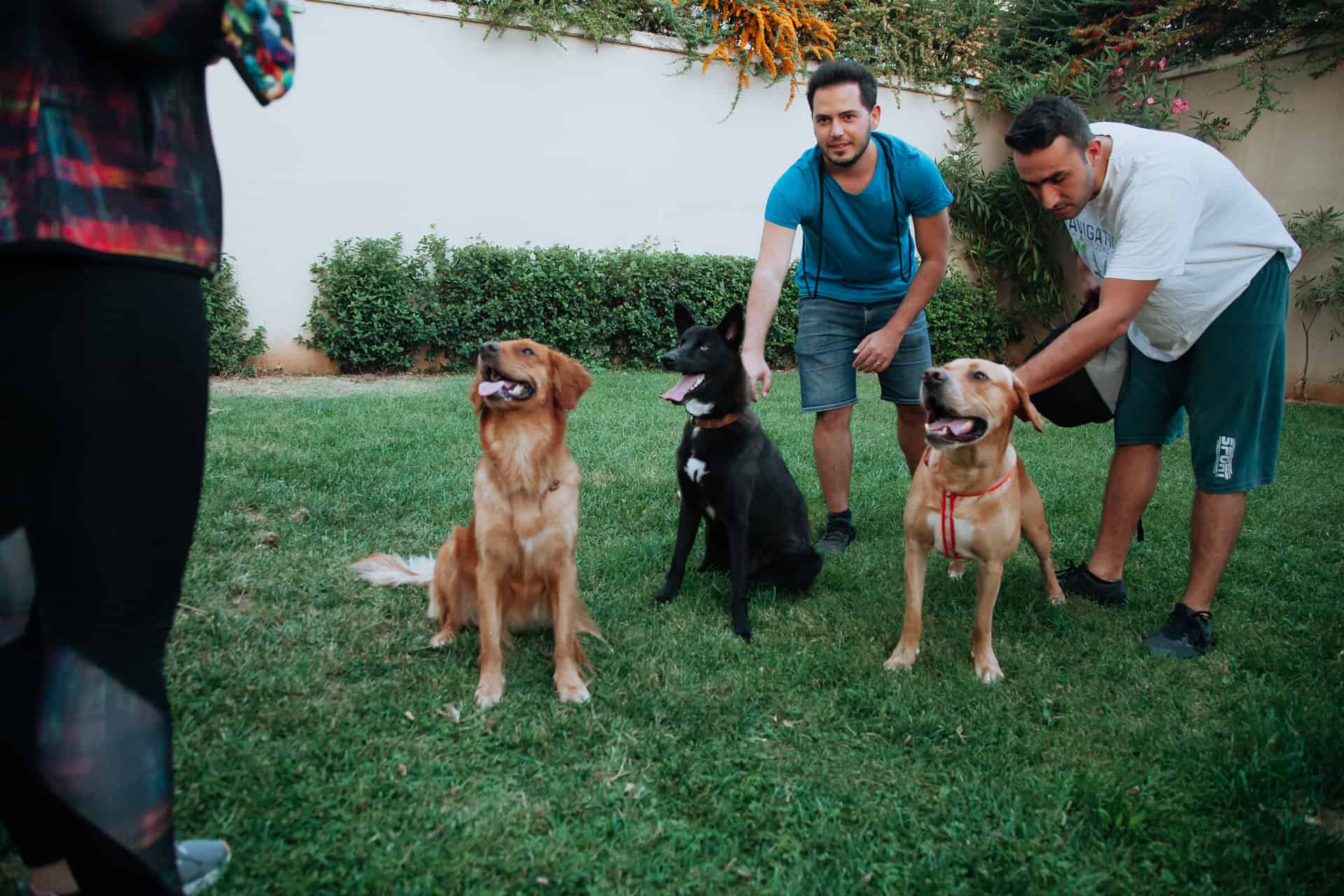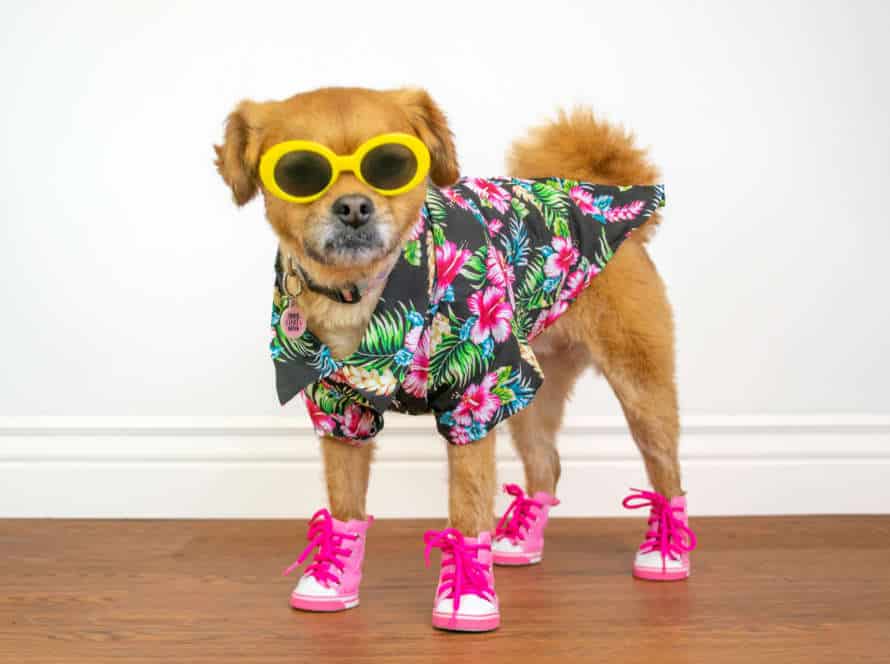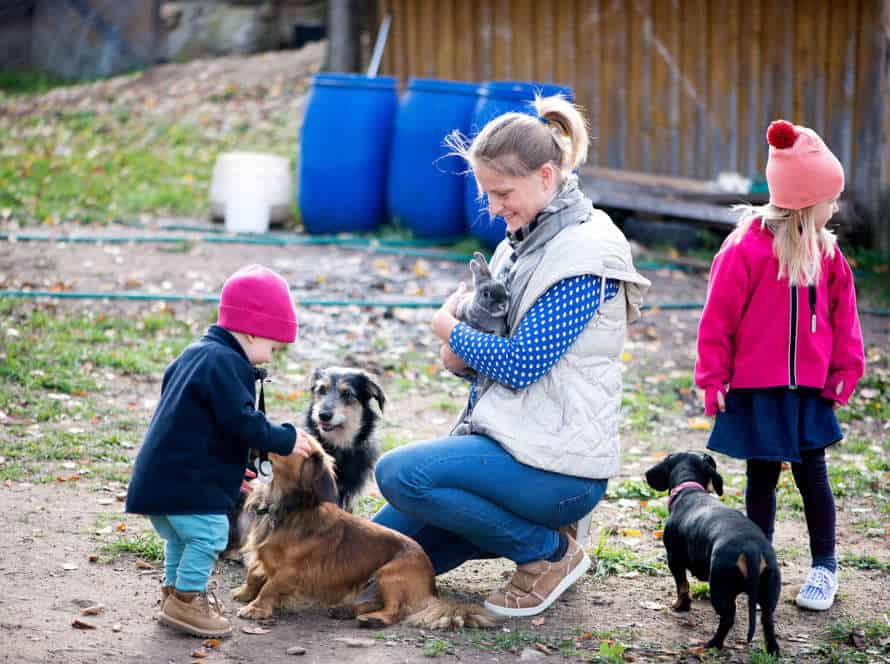Mastering the Art of Training Multiple Dogs
Training one pooch can be tough, but training multiple dogs all at once may seem like a mission impossible! However, with the proper techniques and approach, you can successfully train multiple dogs. Here’s some pointers to help you ace the art of training multiple dogs:
- Train each pup one-by-one before attempting to train them together.
- Utilize individual treats to reward each pup separately for good behavior during group training.
- Speak command words that are simple to differentiate, to avoid confusion.
- Designate a space or crate for each pup, to avoid distractions and promote focus while training.
- Make training enjoyable by incorporating games, positive reinforcement, and short sessions.
By following these tips, you can proficiently and efficiently train multiple dogs. Pro Tip: Don’t forget to stay patient and consistent with every pup, making sure they receive even attention and training for the best outcome.
Understanding the Challenges of Training Multiple Dogs
Training many dogs can be intimidating! They all have diverse personalities and tempers. It may also be tricky to train them all at once, as each pup could need different techniques, and it may be hard to monitor each one’s progress. Let’s see what can be done to make the training easier.
Different breeds may require different training methods
Training multiple dogs? Must recognize that breeds vary. Some have unique needs, while others need patient training. For instance, herding breeds like Border Collies & Aussies have strong instincts, good for agility and obedience. But hound breeds like Beagles & Coonhounds are independent, with strong prey drives- tricky to train!
Consistency is key; set boundaries & expectations. Also understand breed traits to create an effective training program.
Dealing with distractions and competition among dogs
Training multiple pooches requires patience and knack. Especially when there’re distractions and rivalry among them. Here’re tips to help you manage the training of many dogs:
- Start with basic commands. Such as “sit“, “stay” and “come“. This will build a base of obedience amongst all.
- Separate the dogs while training. Do each one separately to avoid disruption and competition. Once they’ve nailed the commands, bring them together to practice together.
- Positive reinforcement. Reward the good behaviour with treats, compliments and love. This will make them listen and obey.
- Consistency. Use the same commands and actions every time you train.
- Personal attention. Spend time with each pup individually. This helps build your connection and stops jealousy.
With these tips, managing multiple dogs is possible with patience, consistency and positive attitude.
Handling the physical demands of training multiple dogs
Training multiple puppers can be a fulfilling experience! But, it can also be quite strenuous. You need a lot of patience, vigor, and focus. Here are some difficulties to bear in mind when training more than one pup:
- Giving each dog individual attention and catering to their specific needs can be tricky.
- Keeping the dogs under control and focused can be overwhelming.
- Training two or more doggos at once increases the physical stress of training and requires more energy.
To confront these challenges, set realistic goals, create consistent routines and practice positive reinforcement. You can also get help from a professional pup trainer to deal with the physical demands of training multiple dogs. Pro tip: Take regular breaks and don’t hesitate to ask for help when in need, to avoid physical fatigue.
Preparing for Training
Training a lot of dogs can be daunting. But, planning and getting ready are important for making it go better and be successful. Making a plan will assist in deciding the aims of the training and the techniques used to accomplish them. Knowing the different personalities of the dogs and any potential problems is vital. Let us examine how to get ready for training multiple dogs.
Choosing the right training tools and equipment
Selecting the perfect training equipment is key for being able to teach multiple dogs. Think about these when picking out your tools:
- Collars and leashes are a must-have to manage your pups during sessions. Harnesses are also helpful, especially for bigger or stronger breeds.
- Treats or toys can be used to encourage good behaviour.
- Clickers create a distinct sound, making it easier to communicate with the dogs.
- Whistles can be used for recall training or to get their attention from a distance.
- Training mats or markers help show them where to stay or do certain activities.
Remember to look at each dog’s needs and preferences when deciding. Have patience and keep trying until you find the best tools for you and your pup pals.
Creating individualized training plans for each dog
Creating tailored training plans for each pup is a successful method to train multiple dogs at once. Follow these steps:
- Note each dog’s disposition, nature, and conduct to spot their talents, inadequacies, and training prerequisites.
- Form a training plan specifically for each doggo, taking into account their learning style, concentration span, and development.
- Set achievable targets for each pooch, dividing complex behaviors into small, accomplishable parts.
- Use positive reinforcement techniques such as treats, toys, and compliments to motivate and reward your furry friends for their improvement.
- Keep track of each dog’s training advancement and adjust the training plan as required to tackle any problems or difficulties that may emerge.
Pro Tip: Consistency and tolerance are essential to successfully training multiple dogs. By crafting individualized training plans and staying devoted to the process, you can help each dog reach their maximum potential and reinforce your connection with them.
Establishing a routine to manage time and ensure consistency
Want to manage your time and be consistent when training multiple dogs? Here’s how:
- Create a schedule that fits you and your dogs. Think about the time of day, session length and who’s being trained.
- Prioritize consistency. Use the same routine, commands and rewards every day.
- Time each session with a timer or stopwatch, and keep them the same length for each pup.
- Start with basic commands then move to more complex tasks as each pup progresses.
- Make notes on each pup’s progress. Adjust your routine if needed.
These tips will help you maximize your time and ensure your pup’s success in their training.
Techniques for Training Multiple Dogs
Training many pooches? It can be tough. But, it’s worth it! Have patience and stay consistent. There are helpful approaches to make it simpler and more successful. In this article, we’ll go over the top techniques for training multiple dogs.
Group Training vs. Individual Training
Group and individual training are two techniques for training multiple dogs. Both have their pros and cons, so the decision comes down to your goals, your pup’s needs, and your schedule.
Group training is great for socializing your dog, plus it’s more affordable. But it has some downsides. This includes less one-on-one attention, more distractions, and the instructor may favor certain dogs over others.
Individual training is great for dogs with special behavior or training needs. It also lets you set your own schedule and focus on specific commands. However, it can be costlier than group training and may not offer the same socialization advantages.
The ultimate answer lies in your preferences and your pup’s needs. Maybe a combo of both group and individual training is the best way to master the art of training multiple dogs.
Positive Reinforcement Training
Positive reinforcement training is a great way to train dogs. It works by rewarding good behavior, while avoiding punishing bad. Perfect for multiple pups! Here are some tips to master this method:
- Train one dog at a time until they know the desired behavior.
- Once that pup has got it, introduce another and repeat.
- Use a unique sound or phrase to let them know a reward is coming – like a clicker or a phrase.
- Keep training sessions short and on-topic. Patience is key!
- Consistently, and immediately, reinforce good behavior with treats, praise, or playtime.
- Don’t use punishment or negative reinforcement – it can cause fear and confusion.
Clicker Training for Multiple Dogs
Training multiple dogs can be tough, but clicker training makes it easier! Here’s how to ace it:
- Use different colored clickers for each pup to avoid mix-ups.
- Train each dog separately first to teach them the basics.
- Start with basic commands like ‘sit’ and ‘stay’ and move onto more complex things.
- Set individual goals for each pup and reward them when they reach them.
- Be consistent with your training – reward good behavior and ignore bad.
With patience and consistency, clicker training is a great way to train multiple dogs!
Addressing Behavioral Issues
Training more than one pup can be tricky. Their obedience levels can vary, so you’ll need to adjust your approach accordingly. Plus, when you have multiple dogs, undesirable behaviors can arise. To address them, it’s necessary to identify the root of them and apply suitable strategies for teaching your pooches.
Aggression or dominance behavior between dogs
Aggression or dominance between dogs can be an issue for pet owners with multiple dogs. Addressing these behaviors can be done with the right training techniques.
Here’s how to master training multiple dogs:
- Set clear rules. Dogs need boundaries and to know their place in the hierarchy. Rules must be followed consistently.
- Socialize your dogs. Introduce them to different settings, people, and other dogs.
- Use positive reinforcement. Treats and praise can motivate your dogs to keep up good behavior.
- Be consistent. Use the same training with all dogs to avoid sending mixed messages.
- Get professional help. If aggression or dominance persists, get a pro dog trainer.
Don’t forget: Patience and consistency are key for successful behavior training.
Overexcitement and hyperactivity
Overexcitement and hyperactivity are common when training multiple dogs. Mastering these issues requires consistency and patience. Here are some tips:
- Start with basic commands such as “sit, stay, come,” and “heel.”
- Train one dog at a time for maximum focus. Then, train them together in a controlled environment.
- Shorten sessions and reward good behavior with treats and praise. Be patient and consistent, and correct any unwanted behavior instantly.
- Use positive reinforcement and structured playtime to help your dogs expend energy and reduce overexcitement. Pro tip: Clicker training can improve focus during training sessions.
Resource guarding and territorial behavior
Resource guarding and territorial behavior are common in multiple-dog households. Resource guarding means a dog will protect its food, toys, and other items from other dogs or people. Territorial behavior means a dog will protect its physical space from other dogs or people. If not stopped quickly, these behaviors can cause fights between dogs and even aggression.
To prevent resource guarding and territorial behavior among multiple dogs, take these steps:
- Give each dog its own spot and time to eat.
- Set up separate places for sleeping and resting for each dog.
- Use positive reinforcement techniques to teach your dogs to share and play calmly.
- Get help from a professional dog trainer or behaviorist if the problem persists or gets worse.
A pro tip: Quickly identify and stop resource guarding and territorial behavior so they don’t get out of hand.
Maintaining Training Success
Training multiple dogs is a challenge. To succeed, consistency is key. You must apply the same training to each pup and have them meet the same standard. But, this can be difficult to do when training multiple dogs. Here are some tips to maintain success when training numerous dogs:
Consistency in training routine and methods
Create consistency for successful training.
For you and your furry friends, this means a harmonious environment.
Establish a routine and method that works for all dogs.
This avoids confusion, bringing predictability to your pups.
Use clear commands that all understand.
Always reinforce positive behaviour with treats, praise, or playtime.
Don’t confuse them with different training methods or techniques.
Set aside time for each dog’s individual needs.
By consistently following a training routine and method, you can get a well-trained and happy pack.
Regular assessment and adjustment of individual training plans
Regularly assess and adjust each dog’s individual training plan to maintain success in training multiple dogs. Here are some tips for mastering this art:
- Assess progress regularly – monitor each dog’s pace and identify areas needing extra attention.
- Adjust plans as needed – tailor to each dog’s personality and learning style.
- Separate training sessions – avoid confusion and ensure each dog gets the attention they need.
- Be patient and dedicated – it can be challenging, but with patience and dedication, help each dog reach their potential.
Continual reinforcement of desired behaviors
To keep training multiple dogs successful, you must continuously reinforce desired behaviours. Do this with positive reinforcement and be consistent in your training. Here are some tips:
- Reward good behaviour. This could be treats, words of praise, or a head pat.
- Exercise regularly. Even a few minutes a day is enough.
- Be consistent. Use the same commands and rewards with all dogs.
- Use positive reinforcement. Reward good behaviour and avoid punishing bad behaviour. Positive reinforcement will make them do more of what earns rewards.
By continually reinforcing desired behaviours, you can ensure your dogs stay obedient and well-behaved.
Frequently Asked Questions
Q: Is it possible to train multiple dogs at once?
A: Yes, it is possible to train multiple dogs at once. However, it requires a different approach and certain strategies to effectively teach all of them simultaneously.
Q: What are some tips for training multiple dogs together?
A: Some tips for training multiple dogs include keeping a firm control over the environment, being consistent with commands, and providing individual attention to each dog during training sessions.
Q: How do I prevent my dogs from becoming distracted during training sessions?
A: One effective method is to create a designated training area that is free from distractions. You can also use treats or toys to keep their focus during training.
Q: Can I train dogs of different ages and breeds together?
A: Yes, you can train dogs of different ages and breeds together. However, you need to consider their individual needs and adjust the training accordingly.
Q: How do I prevent my dogs from competing with each other during training?
A: One way to prevent competition is to use positive reinforcement instead of punishment. Each dog should be rewarded for good behavior, and they should not feel like they have to compete for attention or treats.
Q: What should I do if one of my dogs is not responding to the training?
A: If one of your dogs is not responding to training, you may need to adjust your training method or seek professional help. It may also be helpful to separate the dog from the others during training sessions to provide more individual attention.







